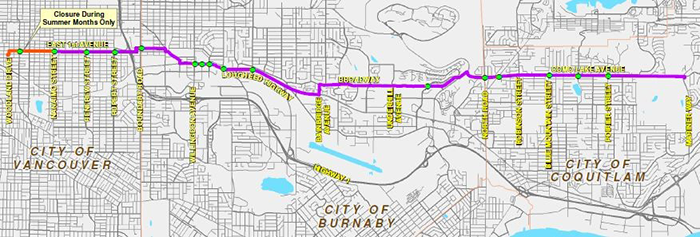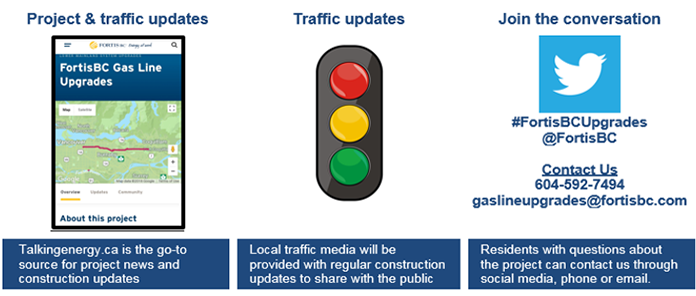Construction of FortisBC Gas Line Upgrade set to start in spring 2018
Apr 5, 2018
VANCOUVER, BC – Residents, businesses and commuters should prepare for traffic congestion in the coming months as FortisBC begins gas line construction this spring. The 20-kilometre natural gas line, running from Vancouver to Coquitlam, has been a vital piece of the natural gas system for 60 years; however, the time has come to replace it to ensure safe and reliable service to 210,000 FortisBC customers in the Lower Mainland.
“We recognize that any urban infrastructure project – whether it’s a sewer or water line replacement, or a gas line upgrade like this project – will cause some disruption for residents and commuters during construction,” said Douglas Stout, vice-president, market development and external relations at FortisBC. “That’s why we’re closely engaged with Vancouver, Burnaby, Coquitlam and TransLink to mitigate those impacts, while keeping the public up to date so they can plan ahead and adjust their routines if needed.”
The most significant construction impacts this year will be along East 1st Avenue in Vancouver, which is scheduled to be fully closed between Clark Drive and Nanaimo Street this summer from mid-June to August 31st. East 1st Ave. will also see partial lane closures between Nanaimo Street and Boundary Road once construction begins later this spring.
“We know there will be congestion, so we appreciate commuters’ patience and encourage them to plan for extra time to reach their destinations,” Stout said. “FortisBC will work as safely and quickly as possible to reduce the impact of our construction.”
The new line will improve the safety and reliability of the system while increasing capacity as Lower Mainland communities continue to grow. The existing 20-inch pipe between Vancouver and Coquitlam will be upgraded to 30-inch pipe. Existing facilities at Mariner Way and Spuraway Avenue in Coquitlam and at East 2nd Avenue and Woodland Drive in Vancouver will also be improved to serve the new line and the customers who depend on it. Three hundred metres of gas line in south Vancouver will also be replaced.
Backgrounder
Quick facts: Vancouver to Coquitlam gas line
1958 year the gas line was built
210,000 FortisBC customers supplied by this natural gas line
20 kilometres of 20-inch gas line will be replaced with 30-inch steel gas line
$33.3 million in procurement on the project to date
Why we’re replacing the gas line
- “The gas line from Coquitlam to Vancouver has been in service since the late 1950s and is nearing the end of its operating life,” said Douglas Stout, vice president, market development and external relations, FortisBC. “We’re replacing it to ensure our Metro Vancouver customers continue to enjoy the comfort and convenience of natural gas.”
How we chose the route
- “Our top priority on all of our projects is the safety of our employees, contractors and the public,” said Melanie Kilpatrick, project director, FortisBC. “A number of factors were considered during the route selection process, including providing a safe workspace for our crews to work in and minimizing impact to the public.”
Project timeline
- Late 2019 – 20-kilometre natural gas line construction complete
- Spring 2018 – Construction contract awarded and construction starts
- Spring to fall 2017 – Pre-construction activities
- Spring to fall 2016 – Detailed engineering studies
- Fall 2015 – B.C. Utilities Commission approval
- Summer 2015 – Early engineering studies, refinements based on public feedback
- Spring 2014 – Consultation with key stakeholders, public open houses
Work is already underway
- Early work on the project began in February 2017 to prepare sites along the route for construction this spring. Tree clearing was done in two phases outside of the bird nesting season, with the majority of work taking place in Burnaby along Broadway from Underhill Avenue to Production Way.
- This work allowed FortisBC to extend culverts protecting three streams and to improve access to where the new gas line will be constructed.
- This early construction work also included the installation of two laterals in Coquitlam and 80 metres of gas line in Vancouver.
Backgrounder
Traffic impacts

Major road closures
The table below includes our current schedule for major traffic impacts. The most up-to-date information, including any schedule changes, will be made available through Talkingenergy.ca #FortisBCUpgrades
| Vancouver | Cross streets | Status | Dates |
|---|---|---|---|
| East 1st Avenue | Clark Dr. to Nanaimo St. | Full road closure | Mid June to end of August 2018 |
| East 1st Avenue | Nanaimo St. to Boundary Rd. | Ongoing lane closures | Spring to winter 2018 |
| Burnaby | Cross streets | Status | Dates |
|---|---|---|---|
| Graveley St | Boundary Rd. to Gilmore Ave. | Ongoing lane closures | Spring 2018 |
| Douglas Rd. | Gilmore Ave. to Madison Ave. | Ongoing lane closures | Spring 2018 |
| Lougheed Hwy. | Madison Ave. to Bainbridge Ave. | Ongoing lane closures | Summer 2018 |
| Broadway | Bainbridge Ave. to Underhill Ave. | Full road closure | Summer 2018 |
| Broadway | Production Way to North Rd. | Ongoing lane closures | Fall 2018 |
| Coquitlam | Cross streets | Status | Dates |
|---|---|---|---|
| Como Lake Ave. | North Rd. to Mariner Way | Ongoing lane closures | 2019 |
Plan ahead
Whatever your mode of transportation, plan ahead by checking FortisBC’s TalkingEnergy.ca website or local traffic media before you go for the latest information on upcoming road closures. In general, driving times will be longer than usual as traffic flows onto other busy routes so consider the alternatives:
- Choose public transit: Avoid congestion by leaving vehicles parked at home
- Adjust your routine: Travel outside of rush hour, if you can
- Change your mode: Take more trips by walking or biking, whenever possible
- Share a ride: If driving is a must, consider carpooling with someone who’s going your way
- Take your time: No matter how you go, arriving at your destination will take longer
- Know your route before you commute: Traffic updates will be shared with media and FortisBC’s TalkingEnergy.ca website.
Backgrounder
Keeping the public informed
FortisBC is committed to providing up to date information on construction and traffic impacts.

Construction methods
There are two main construction methods that we’re using on this project to install our natural gas lines.
- Open cut construction: The type of gas line construction most people are familiar with is open cut, also known as traditional trench construction, which is similar to municipal projects such as sewer and water line upgrades. An open trench is dug and the gas line is laid in the trench. The trench is then refilled and the area is either repaved or restored, depending on where the trench was dug.
- Lane closures are necessary during open cut construction. You’ll see flag personnel controlling traffic and heavy equipment such as excavators onsite.
- Trenchless construction: This method involves digging a tunnel underground, then pushing the gas line through. One advantage of trenchless construction is that it minimizes traffic disruptions. This method will be used at many of the major intersections that cross the project.
Media contact
FortisBC
fortisbc.com
@fortisBC
24-hour media line: 1-855-322-6397
FortisBC is a regulated utility focused on providing safe and reliable energy, including natural gas, electricity and propane. FortisBC employs approximately 2,300 British Columbians and serves approximately 1.1 million customers in 135 B.C. communities. FortisBC owns and operates two liquefied natural gas storage facilities and four regulated hydroelectric generating plants, approximately 7,260 kilometres of transmission and distribution power lines, and approximately 49,000 kilometres of natural gas transmission and distribution pipelines. FortisBC Energy Inc. is a subsidiary of Fortis Inc., a leader in the North American regulated electric and gas utility industry. For further information visit fortisinc.com.